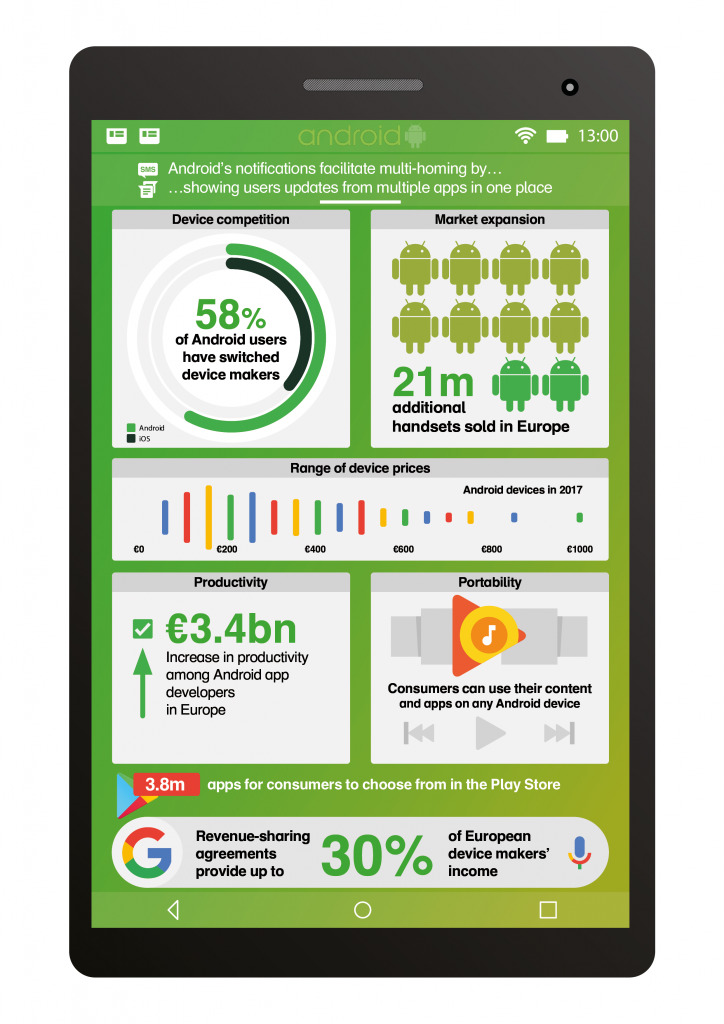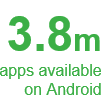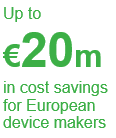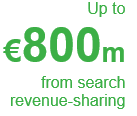Android in Europe: benefits to consumers and businesses
Smartphones have become central to our digital lives. We use them to connect with our friends and family, and to access information, entertainment and markets. With competition enforcers increasingly intervening in digital markets and regulatory authorities examining many of the issues that can arise in these markets, it is vital to understand how the smartphone ecosystem generates value for society. Google asked Oxera to consider the benefits that the Android ecosystem brings to consumers, businesses and digital markets in Europe.
The Android ecosystem plays an important role in Europe’s digital economy, as a multi-sided platform bringing together businesses and consumers across a range of devices. The ecosystem’s success rests on creating a virtuous circle of growth by stimulating both ‘sides’ of the market. Increasing user numbers attracts app developers and service providers, which in turn attract more users, so continuing the growth. This virtuous circle was made possible by a number of key product design and business model decisions by Google.

How do consumers benefit from Android?
By providing an integrated ecosystem that minimises lock-in, Android facilitates device switching and stimulates competition between handset makers, resulting in a wide choice of features and price points for consumers.
The range of devices and choice of apps available with Android gives the ecosystem a broad appeal. Having surveyed 6,000 smartphone users from around Europe, we identified four distinct types of Android user. Each type of user has a different level of sophistication and differing wants and needs when it comes to their smartphones.

Since Android runs on a wide selection of devices at a range of price points, the ecosystem can cater for both these ends of the spectrum, and everyone in between. Importantly, as Android provides a consistent OS across all these devices, the economies of scale and scope attract a wide range of competing app developers. With 3.8m apps currently available, Android users benefit from a long tail of niche apps, with an increased choice set.
Android’s user interface design also plays an important role in enabling the vibrant ecosystem, facilitating multi-homing by users across a selection of apps providing similar services. For example, system notifications allow users to multi-home on several different messaging and social media apps while still having a single ‘port of call’ for new information, regardless of its source.

Android also facilitates choice and competition in devices. Purchased apps and content are easily portable between devices, meaning that Android increases the scope for users to switch between devices as their needs develop or new offers are launched in the market. We find that 58% of Android users switched to a device from a different manufacturer when they last changed their phone.
By making Android freely available to device makers, Google has helped to reduce the cost of smartphones. As well as building a wider user base for app and service providers to cater for, Android being offered free of charge has allowed more consumers to enjoy the benefits of smartphones at an appropriate price for them. We estimate that, in 2017, the free Android licence resulted in around 21m more handsets being sold in Europe than in a scenario in which Google charges device makers, and hence consumers, a fee for the use of the Android operating system.
What does Android offer to app developers?
By minimising fragmentation between devices, Google ensured app developers could tap into the large Android user base with ‘write once, run anywhere’ code, allowing even niche apps to reach commercial scale. In addition, by making the code open source and supporting a wide range of popular programming languages, Google maximised the developer community and enabled the re-use of existing skills and code, leading to greater productivity and innovation on the platform.
The large, global Android user base provides the scale necessary to ensure commercial viability for developers—particularly for the long tail of smaller, bespoke apps and services. A number of system services offered by the core Android OS, as well as others available on Android via the Google Play Services bundle, can help developers attract users and monetise their apps.
App developers benefit from Google’s efforts to reduce the fragmentation of Android across devices. Fragmentation occurs if device makers modify the Android open source code (known as ‘forking’) to create bespoke versions of the OS that are incompatible with the core version of Android that Google released. Google seeks to limit this fragmentation by asking device makers to enter into an ‘Android Compatibility Commitment’.
In providing a focal technology around which a wide community of developers and device makers can congregate, Android enhances the productivity of the entire app development sector through a ‘virtual agglomeration’ effect. This stems from the knowledge spillover that occurs when professionals work together on closely related products and services. We estimate that virtual agglomeration around the Android technologies has led to an 8% productivity increase among app developers, worth around €3.4bn per year in Europe.
Why do device makers choose Android?
By licensing Android to device manufacturers free of charge, Google reduced the price of Android handsets, so increasing its accessibility for users.

Android offers the chance to run a well-maintained, robust and thoroughly tested OS on their device at no additional cost. As well as reducing production costs, the use of a ready-made OS reduces the time to market for a new product. How much device makers save depends on their scale and product range. Having surveyed 10 European device makers, we find savings of at least €15,000 from choosing Android, with some reaching up to €20m in cost avoided. For smaller device makers, choosing Android allows them to offer their customers instant access to the wider app and service ecosystem. Without Android, each new device maker would need to build its own catalogue of apps and services, which is expensive and takes time to establish.

As well as saving money and providing a richer experience for the users of devices, Android allows the device makers to cross-subsidise the cost of their devices through a revenue-sharing agreement (RSA). Under the RSA, the device maker takes a share of any revenue generated by Google searches conducted from the device. We find this revenue share to be material, with our sample of European device makers reporting that this revenue is worth between €2m and €800m (depending on the device makers’ scale).
Key Contact
Please get in touch at [email protected]
